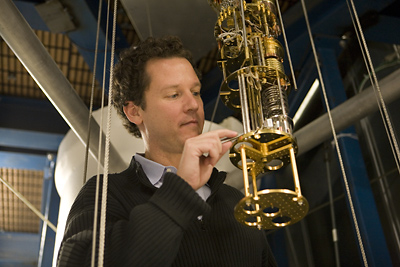Home > Press > Physicist's innovative technique makes atomic-level microscopy at least 100 times faster
 |
| University Photography
Cornell Professor Keith Schwab works on a low-temperature apparatus similar to that used in the paper reported in this weeks issue of Nature. |
Abstract:
Using an existing technique in a novel way, Cornell physicist Keith Schwab and colleagues at Cornell and Boston University have made the scanning tunneling microscope (STM) -- which can image individual atoms on a surface -- at least 100 times faster.
Physicist's innovative technique makes atomic-level microscopy at least 100 times faster
ITHACA, NY | Posted on October 31st, 2007The simple adaptation, based on a method of measurement currently used in nano-electronics, could also give STMs significant new capabilities -- including the ability to sense temperatures in spots as small as a single atom, and to detect changes in position as tiny as 0.00000000000001 meters: a distance 30,000 times smaller than the diameter of an atom.
The finding is described in the Nov. 1 issue of the journal Nature.
The STM uses quantum tunneling, or the ability of electrons to "tunnel" across a barrier, to detect changes in the distance between a needlelike probe and a conducting surface. Researchers apply a tiny voltage to the sample and move the probe -- a simple platinum-iridium wire snipped to end in a point just one atom wide -- just a few angstroms (10ths of a nanometer) over the sample's surface. By measuring changes in current as electrons tunnel between the sample and the probe, they can reconstruct a map of the surface topology down to the atomic level.
Since its invention in the 1980s, the STM has enabled major discoveries in fields from semiconductor technology to nano-electronics.
But while current can change in a nanosecond, measurements with the STM are painfully slow. And the limiting factor is not in the signal itself: It's in the basic electronics involved in analyzing it. A theoretical STM could collect data as fast as electrons can tunnel -- at a rate of one gigahertz, or 1 billion cycles per second of bandwidth. But a typical STM is slowed down by the capacitance, or energy storage, in the cables that make up its readout circuitry -- to about one kilohertz (1,000 cycles per second) or less.
Researchers have tried a variety of complex remedies. But in the end, said Schwab, an associate professor of physics at Cornell, the solution was surprisingly simple. By adding an external source of radio frequency (RF) waves and sending a wave into the STM through a simple network, the researchers showed that it's possible to detect the resistance at the tunneling junction -- and hence the distance between the probe and sample surface -- based on the characteristics of the wave that reflects back to the source.
The technique, called reflectometry, uses the standard cables as paths for high-frequency waves, which aren't slowed down by the cables' capacitance.
"There are six orders of magnitude between the fundamental limit in frequency and where people are operating," said Schwab. With the RF adaptation, speeds increase by a factor of between 100 and 1,000. "Our hope is that we can produce more or less video images, as opposed to a scan that takes forever."
The setup also offers potential for atomic resolution thermometry -- precise measurements of temperature at any particular atom on a surface -- and for motion detection so sensitive it could measure movement of a distance 30,000 times smaller than the size of an atom.
"This STM will be used for a lot of good physics experiments," said Schwab. "Once you open up this new parameter, all this bandwidth, people will figure out ways to use it. I firmly believe 10 years from now there will be a lot of RF-STMs around, and people will do all kinds of great experiments with them."
The research was supported by the National Science Foundation.
####
For more information, please click here
Contacts:
Lauren Gold
(607) 255-9736
Press Relations Office
(607) 255-6074
Issuers of news releases, not 7th Wave, Inc. or Nanotechnology Now, are solely responsible for the accuracy of the content.
| Related News Press |
Discoveries
![]() Chemical reactions can scramble quantum information as well as black holes April 5th, 2024
Chemical reactions can scramble quantum information as well as black holes April 5th, 2024
![]() New micromaterial releases nanoparticles that selectively destroy cancer cells April 5th, 2024
New micromaterial releases nanoparticles that selectively destroy cancer cells April 5th, 2024
![]() Utilizing palladium for addressing contact issues of buried oxide thin film transistors April 5th, 2024
Utilizing palladium for addressing contact issues of buried oxide thin film transistors April 5th, 2024
Announcements
![]() NRL charters Navy’s quantum inertial navigation path to reduce drift April 5th, 2024
NRL charters Navy’s quantum inertial navigation path to reduce drift April 5th, 2024
![]() Discovery points path to flash-like memory for storing qubits: Rice find could hasten development of nonvolatile quantum memory April 5th, 2024
Discovery points path to flash-like memory for storing qubits: Rice find could hasten development of nonvolatile quantum memory April 5th, 2024
Tools
![]() Ferroelectrically modulate the Fermi level of graphene oxide to enhance SERS response November 3rd, 2023
Ferroelectrically modulate the Fermi level of graphene oxide to enhance SERS response November 3rd, 2023
![]() The USTC realizes In situ electron paramagnetic resonance spectroscopy using single nanodiamond sensors November 3rd, 2023
The USTC realizes In situ electron paramagnetic resonance spectroscopy using single nanodiamond sensors November 3rd, 2023
|
|
||
|
|
||
| The latest news from around the world, FREE | ||
|
|
||
|
|
||
| Premium Products | ||
|
|
||
|
Only the news you want to read!
Learn More |
||
|
|
||
|
Full-service, expert consulting
Learn More |
||
|
|
||








